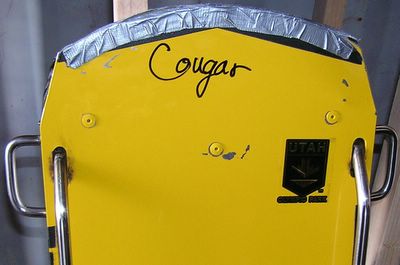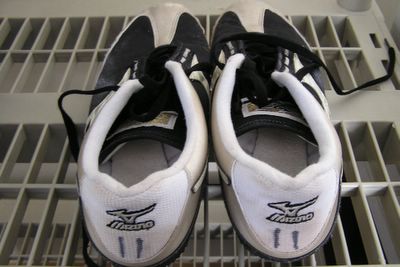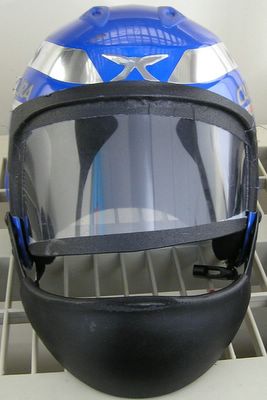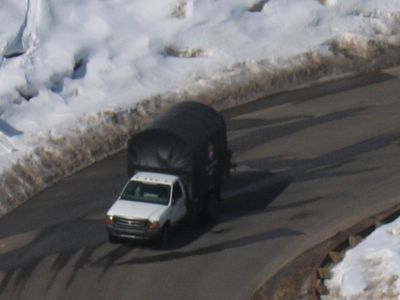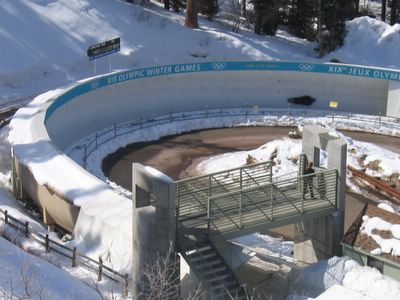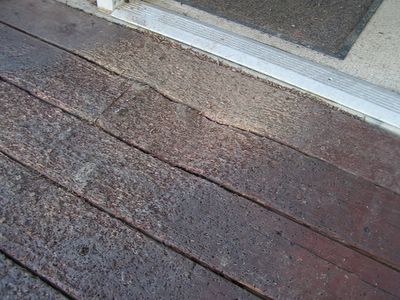1.4.05

My fourth run was very painful. I started off by hitting the wall, and pretty much kept on hitting the entire way down going 57.6 mph. The pads cushioned the blow to my elbows, but my arms where exposed and raw at the bottom. My fifth run was worse because I strained instead of relaxing when taking the hit, which really slowed me down: 53.9 mph.

Now that I think about it, its somewhat hard to write about skeleton. I can list all the things I did before and after but during skeleton I am not really thinking at all. The speed is so intense that my memories of sliding down arent really able to be put into words. Thinking about it brings back this incredible feeling, more of a rush of adrenalin, emotion, and confusion in a blender.
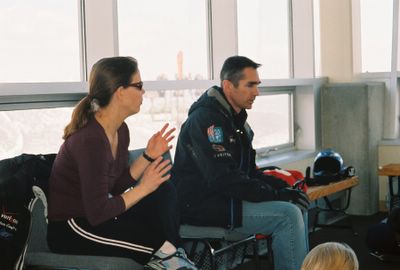
It sure wasnt as easy to get up on the second morning. Since Im only a teenager I can only imagine what the others must have felt like. The second day we started on the Womens Luge Start. We started off at the track operations center where we met U.S. Skeleton team members Brady and Felicia Canfield. They talked about their experiences on the skeleton touring circuit.

When you get to this level skeleton, steering isnt what makes the difference. Its the start that can make or break a race. So the athlete must be in top physical condition for fast and hard start push. Final times are calculated to 1/100th of a second. And this isnt just running: this is pushing a sled that weighs more than 70 pounds 50 meters in less than five seconds.

Recruitment for the sport of skeleton is vastly different than most sports. Since there are only three sled tracks in all of North America, recruitment is done at high school and college track meets. Robbie said often that he, could teach a monkey to steer the sled but [he couldnt] teach you how to run fast.

Although this might be that not the nicest thing said, it was some more reassuring to know that even the professional sliders hit the walls. The only difference was when a professional hit the wall; they had their shoulders inside of the sleds bumpers. Another thing that the professionals were doing was having their head so close to the track that you could hear their chin guard scraping on the ice.

After my first day of skeleton, my coach Robbie wanted us to come back and watch the professionals at the UOP track at about 4:30pm in the afternoon at Curve 12. I still couldnt believe that I was riding the same track Olympians had won gold medals. Robbie was telling us about the future Torino Olympians Zack, Adam, and Chris.

My final run for the day was an arm buster. But before I go on, let me emphasize that skeleton is the safest of the sliding sports (skeleton, bobsled, and luge). There are still risks of bumps, bruises, and the very unlikely occurrences of concussions or your sled flipping. In my case though, the width of my shoulders exceed the width of the sleds steel bumpers, which means any time I hit the wall the sides of my arms absorb the hit instead of the sled. I hit the wall so many times I got a time of 1:04.16 and my arms were impacted at speeds topping 50.6 mph. Did it hurt? It isn't as bad as the pictures look or as it sounds. Was it worth it? The experience of skeleton doesn't have a measurable worth, but yes it was.

My final run for the day was an arm buster. But before I go on, let me emphasize that skeleton is the safest of the sliding sports (skeleton, bobsled, and luge). There are still risks of bumps, bruises, and the very unlikely occurrences of concussions or your sled flipping. In my case though, the width of my shoulders exceed the width of the sleds steel bumpers, which means any time I hit the wall the sides of my arms absorb the hit instead of the sled. I hit the wall so many times I got a time of 1:04.16 and my arms were impacted at speeds topping 50.6 mph.

My first run ever starts off with my helmet on the wrong way, which sucked air into my helmet, which then blew my right contact lens off. I finished 966.5 meters in 53.95 seconds and reached a top speed of 54.2 mph. And then it happened: I became instantly addicted to skeleton. Driving fast, skydiving, roller coasters...all would seem sluggish and insufficient for my desire of skeleton.
As soon as I reached the finish line, I couldnt wait to go again.
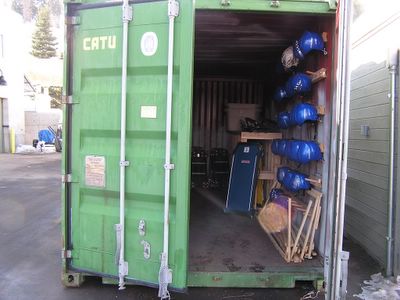
Robbie introduces all of us to what we'll be doing today and the rest of the camp. Robbie shows us the proper form, and gives us all the equipment we'll need: downhill skiing helmet, skeleton sled, and spiked track shoes. We supply our own elbow pads, mouthguard, and gloves. The skeleton equipment is a large storage shed.

United Sates Bobsled and Skeleton Federation (USBSF)
Western Skeleton Coach, Robbie Lyon
Robbie began sliding Luge in 1998, which includes eight years of experience in many capacities on the Utah Olympic Park track. He is a former member of the U.S. Junior National Luge Team where he competed in the 2003 Olympic Trials, U.S. Nationals, U.S. Junior Nationals, North American Championships and the Jr. World Cup Circuit. During his competitive years he won more then 35 medals and in 2002-2003 he was counted as one of the top ten junior athletes in the world. With his extensive knowledge of the lines on the Utah Olympic Park track and his love for the sliding sports he has piloted Summer Bobsled rides (The Comet), is the UOP Head Coach for training new Comet drivers and is a track announcer for all the sliding sports at Utah Olympic Park. His international experience on most every track in the World and his thousands of runs on the Utah Olympic Park track guarantees that he knows ice and he knows lines. Robbie was recently named the Head Skeleton Coach for the University Games to be held in Winterberg, Germany and the Skeleton Junior World Championships in Igles, Austria. The USFSB has also nominated him for the United States Olympic Committee Development Coach of the Year, which will be awarded in the spring of 2005.

4:15am. Not yet. 5:37am. Not yet. 7:25am...that's close enough. My first morning I am so excited; it feels like Christmas is finally here. I rush downstairs to eat breakfast, and get dressed. My dad, Anthony, and I leave our Coalville hotel and drive to Utah Olympic Park in Park City. We arrive at the Day Lodge before anyone else, and sit outside watching the sunrise.
At about 9:15am I check in, where I meet Nate from Iowa. Nate, a sophomore in college, has made around 12 runs at Lake Placid; but this is his first time at UOP. We give Nate a ride up to Track Operations, which is near the end of the run. 10 people file in: Randy, George, Rod, myself, John, Chip, a girl my age named Alyx (no it isn't a typo), Nate, Phil, and Maria. Our instructor is Robbie Lyon, who is the United States Bobsled and Skeleton Federation (USBSF) Western Skeleton Coach.
